Nested Cross-Validation for HBV Conceptual Rainfall–Runoff Model Spatial Stability Analysis in a Semi-Arid Context
Abstract
:1. Introduction
- −
- Can the calibrated HBV model maintain accuracy in reproducing streamflow across various sub-catchments with differing hydroclimatic conditions?
- −
- How stable are the HBV model parameters when transferred between different sub-catchments within the OERB river basin?
- −
- What is the impact of spatiotemporal variability on the performance of the HBV model in a semi-arid context?
2. Materials and Methods
2.1. Study Catchments
2.2. Data Collection and Model Description
2.2.1. Data Collection
2.2.2. Model Description
2.3. Calibration and Validation of the Model
2.4. Nested Cross-Validation
- Gathering hydroclimatic, remotely sensed, and GIS databases from multiple sources relevant to the studied sub-catchments.
- Cross-calibration and validation of the HBV model structure in a donor catchment (AOCH).
- Regionalization of model optimal parameters obtained in the donor catchment (AOCH) to target catchments using nested cross-calibration and validation over 18-year dataset and over 7 sub-catchments of the study area, according to two nested loops:
- Inner Loop: Leave-one-year-out cross-validation for the regionalization of optimal parameter sets obtained from hydrological modeling in the donor catchment from year to year.
- Outer Loop: Leave-one-catchment-out cross-validation for the regionalization of the HBV conceptual model from basin to basin.
- Analyzing the model performances and selecting stable optimal parameters for all the sub-catchments.
2.4.1. Temporal Cross-Validation of the Model: Leave One Year Out
2.4.2. Spatial Cross-Validation of the Model: Leave One Catchment Out
2.4.3. Performance Metrics
- r: The Pearson correlation coefficient between the simulated and observed data;
- α: The ratio of the standard deviation of the simulated values to the standard deviation of the observed values.
- β: The ratio of the mean of the simulated values to the mean of the observed values.
2.4.4. Model Performance Assessment
3. Results and Discussion
3.1. Model Simulation Performances in Donor Catchment
3.2. Regionalization of Model Optimal Parameters Obtained from Donor Catchment (AOCH) to Target Catchments Using Nested Cross-Calibration and Validation
3.2.1. Spatial Stability Analysis
3.2.2. Temporal Stability Analysis
3.3. Performance Loss Analysis
4. Conclusions
Author Contributions
Funding
Data Availability Statement
Acknowledgments
Conflicts of Interest
Appendix A
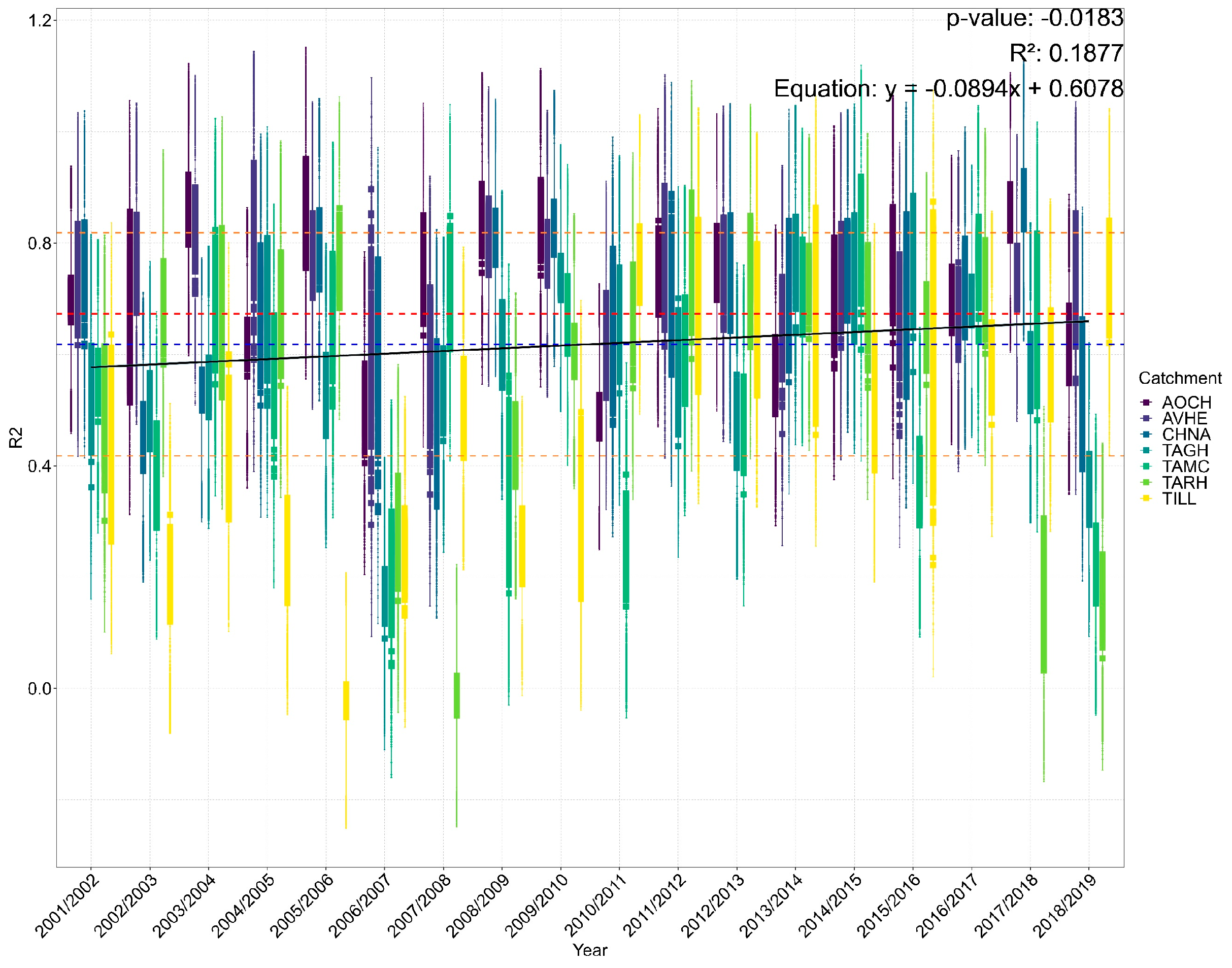

Appendix B
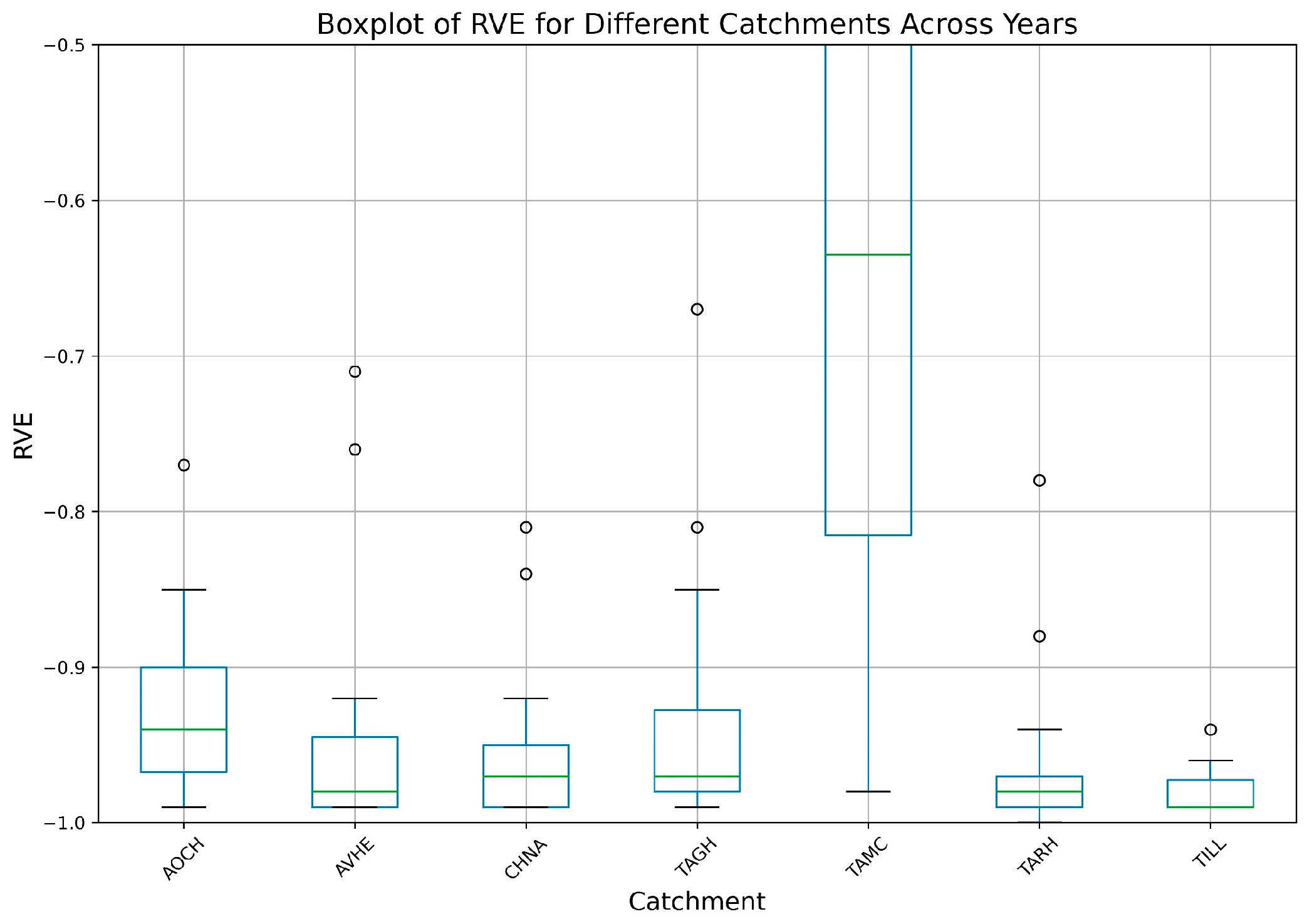
References
- Burek, P.; Satoh, Y.; Fischer, G.; Kahil, M.T.; Scherzer, A.; Tramberend, S.; Nava, L.F.; Wada, Y.; Eisner, S.; Flörke, M. Water Futures and Solution—Fast Track Initiative; IIASA Working Paper; IIASA: Laxenburg, Austria, 2016. [Google Scholar]
- World Water Assessment Programme. The United Nations World Water Development Report 2018; United Nations Educational, Scientific and Cultural Organization: New York, NY, USA, 2018. [Google Scholar]
- Chai, T.; Draxler, R.R. Root Mean Square Error (RMSE) or Mean Absolute Error (MAE)?—Arguments against Avoiding RMSE in the Literature. Geosci. Model Dev. 2014, 7, 1247–1250. [Google Scholar] [CrossRef]
- Hoekstra, A.Y. Water Scarcity Challenges to Business. Nat. Clim. Chang. 2014, 4, 318–320. [Google Scholar] [CrossRef]
- Water Consumption BT. Clean Water and Sanitation; Leal Filho, W., Azul, A.M., Brandli, L., Lange Salvia, A., Wall, T., Eds.; Springer International Publishing: Cham, Switzerland, 2022; p. 774. ISBN 978-3-319-95846-0. [Google Scholar]
- Richter, B.D.; Bartak, D.; Caldwell, P.; Davis, K.F.; Debaere, P.; Hoekstra, A.Y.; Li, T.; Marston, L.; McManamay, R.; Mekonnen, M.M.; et al. Water Scarcity and Fish Imperilment Driven by Beef Production. Nat. Sustain. 2020, 3, 319–328. [Google Scholar] [CrossRef]
- Dalezios, N.R.; Angelakis, A.N.; Eslamian, S. Water Scarcity Management: Part 1: Methodological Framework. Int. J. Glob. Environ. Issues 2018, 17, 1–40. [Google Scholar] [CrossRef]
- Tzanakakis, V.A.; Paranychianakis, N.V.; Angelakis, A.N. Water Supply and Water Scarcity. Water 2020, 12, 2347. [Google Scholar] [CrossRef]
- Boretti, A.; Rosa, L. Reassessing the Projections of the World Water Development Report. NPJ Clean Water 2019, 2, 15. [Google Scholar] [CrossRef]
- OECD. OECD Environmental Outlook to 2050; OECD: Paris, France, 2012; ISBN 9789264122161. [Google Scholar]
- Pokhrel, Y.; Felfelani, F.; Satoh, Y.; Boulange, J.; Burek, P.; Gädeke, A.; Gerten, D.; Gosling, S.N.; Grillakis, M.; Gudmundsson, L.; et al. Global Terrestrial Water Storage and Drought Severity under Climate Change. Nat. Clim. Change 2021, 11, 226–233. [Google Scholar] [CrossRef]
- Tramblay, Y.; Jarlan, L.; Hanich, L.; Somot, S. Future Scenarios of Surface Water Resources Availability in North African Dams. Water Resour. Manag. 2018, 32, 1291–1306. [Google Scholar] [CrossRef]
- Tzanakakis, V.A.; Angelakis, A.N.; Paranychianakis, N.V.; Dialynas, Y.G.; Tchobanoglous, G. Challenges and Opportunities for Sustainable Management of Water Resources in the Island of Crete, Greece. Water 2020, 12, 1538. [Google Scholar] [CrossRef]
- Bates, B.; Kundzewicz, Z.; Wu, S. Climate Change and Water; Intergovernmental Panel on Climate Change Secretariat: Geneva, Switzerland, 2008; ISBN 9291691232. [Google Scholar]
- Driouech, F.; ElRhaz, K.; Moufouma-Okia, W.; Arjdal, K.; Balhane, S. Assessing Future Changes of Climate Extreme Events in the CORDEX-MENA Region Using Regional Climate Model ALADIN-Climate. Earth Syst. Environ. 2020, 4, 477–492. [Google Scholar] [CrossRef]
- Keshav, S. How to Read a Paper. ACM SIGCOMM Comput. Commun. Rev. 2007, 37, 83–84. [Google Scholar] [CrossRef]
- Noto, L.V.; Cipolla, G.; Francipane, A.; Pumo, D. Climate Change in the Mediterranean Basin (Part I): Induced Alterations on Climate Forcings and Hydrological Processes. Water Resour. Manag. 2022, 37, 2287–2305. [Google Scholar] [CrossRef]
- Pellet, V.; Aires, F.; Munier, S.; Fernández Prieto, D.; Jordá, G.; Dorigo, W.A.; Polcher, J.; Brocca, L. Integrating Multiple Satellite Observations into a Coherent Dataset to Monitor the Full Water Cycle—Application to the Mediterranean Region. Hydrol. Earth Syst. Sci. 2019, 23, 465–491. [Google Scholar] [CrossRef]
- Rochdane, S.; Reichert, B.; Messouli, M.; Babqiqi, A.; Khebiza, M.Y. Climate Change Impacts on Water Supply and Demand in Rheraya Watershed (Morocco), with Potential Adaptation Strategies. Water 2012, 4, 28–44. [Google Scholar] [CrossRef]
- Voss, R.; May, W.; Roeckner, E. Enhanced Resolution Modelling Study on Anthropogenic Climate Change: Changes in Extremes of the Hydrological Cycle. Int. J. Climatol. 2002, 22, 755–777. [Google Scholar] [CrossRef]
- Marchane, A.; Tramblay, Y.; Hanich, L.; Ruelland, D.; Jarlan, L. Climate Change Impacts on Surface Water Resources in the Rheraya Catchment (High Atlas, Morocco). Hydrol. Sci. J. 2017, 62, 979–995. [Google Scholar] [CrossRef]
- Boudhar, A.; Baba, W.M.; Marchane, A.; Ouatiki, H.; Bouamri, H.; Hanich, L.; Chehbouni, A. Water Resources Monitoring Over the Atlas Mountains in Morocco Using Satellite Observations and Reanalysis Data BT. In Remote Sensing of African Mountains: Geospatial Tools toward Sustainability; Adelabu, S., Ramoelo, A., Olusola, A., Adagbasa, E., Eds.; Springer International Publishing: Cham, Switzerland, 2022; pp. 157–170. ISBN 978-3-031-04855-5. [Google Scholar]
- Zittis, G.; Bruggeman, A.; Lelieveld, J. Revisiting Future Extreme Precipitation Trends in the Mediterranean. Weather Clim. Extrem. 2021, 34, 100380. [Google Scholar] [CrossRef]
- Sidle, R.C. Strategies for Smarter Catchment Hydrology Models: Incorporating Scaling and Better Process Representation. Geosci. Lett. 2021, 8, 24. [Google Scholar] [CrossRef]
- Aghakouchak, A.; Habib, E. Application of a Conceptual Hydrologic Model in Teaching Hydrologic Processes. Int. J. Eng. Educ. 2010, 26, 963–973. [Google Scholar]
- Coopersmith, E.; Yaeger, M.A.; Ye, S.; Cheng, L.; Sivapalan, M. Exploring the Physical Controls of Regional Patterns of Flow Duration Curves—Part 3: A Catchment Classification System Based on Regime Curve Indicators. Hydrol. Earth Syst. Sci. 2012, 16, 4467–4482. [Google Scholar] [CrossRef]
- Devia, G.K.; Ganasri, B.P.; Dwarakish, G.S. A Review on Hydrological Models. Aquat. Procedia 2015, 4, 1001–1007. [Google Scholar] [CrossRef]
- Duan, Q.; Sorooshian, S.; Gupta, V. Effective and Efficient Global Optimization for Conceptual Rainfall-runoff Models. Water Resour. Res. 1992, 28, 1015–1031. [Google Scholar] [CrossRef]
- Clark, M.P.; Kavetski, D.; Fenicia, F. Pursuing the Method of Multiple Working Hypotheses for Hydrological Modeling. Water Resour. Res. 2011, 47, W09301. [Google Scholar] [CrossRef]
- Singh, V.P. Hydrologic Modeling: Progress and Future Directions. Geosci. Lett. 2018, 5, 15. [Google Scholar] [CrossRef]
- Krysanova, V.; Donnelly, C.; Gelfan, A.; Gerten, D.; Arheimer, B.; Hattermann, F.; Kundzewicz, Z.W. How the Performance of Hydrological Models Relates to Credibility of Projections under Climate Change. Hydrol. Sci. J. 2018, 63, 696–720. [Google Scholar] [CrossRef]
- Bergstrom, S. Experience from Applications of the HBV Hydrological Model from the Perspective of Prediction in Ungauged Basins. IAHS Publ. 2006, 307, 97. [Google Scholar]
- Bouadila, A.; Tzoraki, O.; Benaabidate, L. Hydrological Modeling of Three Rivers under Mediterranean Climate in Chile, Greece, and Morocco: Study of High Flow Trends by Indicator Calculation. Arab. J. Geosci. 2020, 13, 1057. [Google Scholar] [CrossRef]
- Ouachani, R.; Bargaoui, Z.; Ouarda, T. Integration of a Kalman Filter in the HBV Hydrological Model for Runoff Forecasting. Hydrol. Sci. J. 2007, 52, 318–337. [Google Scholar] [CrossRef]
- Ouatiki, H.; Boudhar, A.; Ouhinou, A.; Beljadid, A.; Leblanc, M.; Chehbouni, A. Sensitivity and Interdependency Analysis of the HBV Conceptual Model Parameters in a Semi-Arid Mountainous Watershed. Water 2020, 12, 2440. [Google Scholar] [CrossRef]
- Seibert, J.; Beven, K.J. Gauging the Ungauged Basin: How Many Discharge Measurements Are Needed? Hydrol. Earth Syst. Sci. 2009, 13, 883–892. [Google Scholar] [CrossRef]
- Vrochidou, A.-E.K.; Tsanis, I.K.; Grillakis, M.G.; Koutroulis, A.G. The Impact of Climate Change on Hydrometeorological Droughts at a Basin Scale. J. Hydrol. 2013, 476, 290–301. [Google Scholar] [CrossRef]
- Seibert, J.; Bergström, S. A Retrospective on Hydrological Catchment Modelling Based on Half a Century with the HBV Model. Hydrol. Earth Syst. Sci. 2022, 26, 1371–1388. [Google Scholar] [CrossRef]
- Arheimer, B.; Lindström, G. Climate Impact on Floods: Changes in High Flows in Sweden in the Past and the Future (1911–2100). Hydrol. Earth Syst. Sci. 2015, 19, 771–784. [Google Scholar] [CrossRef]
- Khazaei, M.R.; Heidari, M.; Shahid, S.; Hasirchian, M. Consideration of Climate Change Impacts on a Hydropower Scheme in Iran. Theor. Appl. Climatol. 2024, 155, 3119–3132. [Google Scholar] [CrossRef]
- Kundzewicz, Z.W.; Mata, L.J.; Arnell, N.W.; Doll, P.; Kabat, P.; Jimenez, B.; Miller, K.; Oki, T.; Zekai, S.; Shiklomanov, I. Freshwater Resources and Their Management. In Climate Change 2007: Impacts, Adaptation and Vulnerability. Contribution of Working Group II to the Fourth Assessment Report of the Intergovernmental Panel on Climate Change; Cambridge University Press: Cambridge, UK, 2007. [Google Scholar]
- Xu, C.-Y. Estimation of Parameters of a Conceptual Water Balance Model for Ungauged Catchments. Water Resour. Manag. 1999, 13, 353–368. [Google Scholar] [CrossRef]
- Dakhlaoui, H.; Ruelland, D.; Tramblay, Y.; Bargaoui, Z. Evaluating the Robustness of Conceptual Rainfall-Runoff Models under Climate Variability in Northern Tunisia. J. Hydrol. 2017, 550, 201–217. [Google Scholar] [CrossRef]
- Giorgi, F.; Lionello, P. Climate Change Projections for the Mediterranean Region. Glob. Planet. Change 2008, 63, 90–104. [Google Scholar] [CrossRef]
- Blöschl, G.; Montanari, A. Climate Change Impacts—Throwing the Dice? Hydrol. Process. Int. J. 2010, 24, 374–381. [Google Scholar] [CrossRef]
- Mao, G.; Wang, M.; Liu, J.; Wang, Z.; Wang, K.; Meng, Y.; Zhong, R.; Wang, H.; Li, Y. Comprehensive Comparison of Artificial Neural Networks and Long Short-Term Memory Networks for Rainfall-Runoff Simulation. Phys. Chem. Earth Parts A/B/C 2021, 123, 103026. [Google Scholar] [CrossRef]
- Parajka, J.; Blöschl, G.; Merz, R. Regional Calibration of Catchment Models: Potential for Ungauged Catchments. Water Resour. Res. 2007, 43, W06406. [Google Scholar] [CrossRef]
- Guo, Y.; Zhang, Y.; Zhang, L.; Wang, Z. Regionalization of Hydrological Modeling for Predicting Streamflow in Ungauged Catchments: A Comprehensive Review. WIREs Water 2021, 8, e1487. [Google Scholar] [CrossRef]
- Kokkonen, T.S.; Jakeman, A.J.; Young, P.C.; Koivusalo, H.J. Predicting Daily Flows in Ungauged Catchments: Model Regionalization from Catchment Descriptors at the Coweeta Hydrologic Laboratory, North Carolina. Hydrol. Process. 2003, 17, 2219–2238. [Google Scholar] [CrossRef]
- McIntyre, N.; Lee, H.; Wheater, H.; Young, A.; Wagener, T. Ensemble Predictions of Runoff in Ungauged Catchments. Water Resour. Res. 2005, 41, W12434. [Google Scholar] [CrossRef]
- Mosley, M.P. Delimitation of New Zealand Hydrologic Regions. J. Hydrol. 1981, 49, 173–192. [Google Scholar] [CrossRef]
- Riggs, H.C. Low-Flow Investigations; US Government Printing Office: Washington, DC, USA, 1972.
- Song, Z.; Xia, J.; Wang, G.; She, D.; Hu, C.; Hong, S. Regionalization of Hydrological Model Parameters Using Gradient Boosting Machine. Hydrol. Earth Syst. Sci. 2022, 26, 505–524. [Google Scholar] [CrossRef]
- Blöschl, G.; Sivapalan, M. Scale Issues in Hydrological Modelling: A Review. Hydrol. Process. 1995, 9, 251–290. [Google Scholar] [CrossRef]
- Seibert, J. Regionalisation of Parameters for a Conceptual Rainfall-Runoff Model. Agric. For. Meteorol. 1999, 98–99, 279–293. [Google Scholar] [CrossRef]
- Beck, H.E.; Pan, M.; Lin, P.; Seibert, J.; van Dijk, A.I.J.M.; Wood, E.F. Global Fully Distributed Parameter Regionalization Based on Observed Streamflow From 4,229 Headwater Catchments. J. Geophys. Res. Atmos. 2020, 125, e2019JD031485. [Google Scholar] [CrossRef]
- Garambois, P.A.; Roux, H.; Larnier, K.; Labat, D.; Dartus, D. Parameter Regionalization for a Process-Oriented Distributed Model Dedicated to Flash Floods. J. Hydrol. 2015, 525, 383–399. [Google Scholar] [CrossRef]
- Li, H.; Zhang, Y.; Chiew, F.H.S.; Xu, S. Predicting Runoff in Ungauged Catchments by Using Xinanjiang Model with MODIS Leaf Area Index. J. Hydrol. 2009, 370, 155–162. [Google Scholar] [CrossRef]
- Oudin, L.; Andréassian, V.; Perrin, C.; Michel, C.; Le Moine, N. Spatial Proximity, Physical Similarity, Regression and Ungaged Catchments: A Comparison of Regionalization Approaches Based on 913 French Catchments. Water Resour. Res. 2008, 44, W03413. [Google Scholar] [CrossRef]
- Parajka, J.; Merz, R.; Blöschl, G. A Comparison of Regionalisation Methods for Catchment Model Parameters. Hydrol. Earth Syst. Sci. 2005, 9, 157–171. [Google Scholar] [CrossRef]
- Reichl, J.P.C.; Western, A.W.; McIntyre, N.R.; Chiew, F.H.S. Optimization of a Similarity Measure for Estimating Ungauged Streamflow. Water Resour. Res. 2009, 45, W10423. [Google Scholar] [CrossRef]
- Singh, R.; Archfield, S.A.; Wagener, T. Identifying Dominant Controls on Hydrologic Parameter Transfer from Gauged to Ungauged Catchments–A Comparative Hydrology Approach. J. Hydrol. 2014, 517, 985–996. [Google Scholar] [CrossRef]
- Gupta, H.V.; Nearing, G.S. Debates-the Future of Hydrological Sciences: A (Common) Path Forward? Using Models and Data to Learn: A Systems Theoretic Perspective on the Future of Hydrological Science. Water Resour. Res. 2014, 50, 5351–5359. [Google Scholar] [CrossRef]
- Boudhar, A.; Hanich, L.; Boulet, G.; Outaleb, K.; Arioua, A.; Ben, B.; Hakkani, B. Etude de La Disponibilité Des Ressources En Eau à l’aide de La Télédétection et La Modélisation: Cas Du Bassin Versant d’Oum Er Rbia (Maroc). In Proceedings of the 3éme Colloque International Eau-Climat, Hammamet, Tunisia, 21–23 October 2014. [Google Scholar]
- Strohmeier, S.; López López, P.; Haddad, M.; Nangia, V.; Karrou, M.; Montanaro, G.; Boudhar, A.; Linés, C.; Veldkamp, T.; Sterk, G. Surface Runoff and Drought Assessment Using Global Water Resources Datasets—From Oum Er Rbia Basin to the Moroccan Country Scale. Water Resour. Manag. 2020, 34, 2117–2133. [Google Scholar] [CrossRef]
- El Khalki, E.M.; Tramblay, Y.; Hanich, L.; Marchane, A.; Boudhar, A.; Hakkani, B. Climate Change Impacts on Surface Water Resources in the Oued El Abid Basin, Morocco. Hydrol. Sci. J. 2021, 66, 2132–2145. [Google Scholar] [CrossRef]
- Ouatiki, H.; Boudhar, A.; Ouhinou, A.; Arioua, A.; Hssaisoune, M.; Bouamri, H.; Benabdelouahab, T. Trend Analysis of Rainfall and Drought over the Oum Er-Rbia River Basin in Morocco during 1970–2010. Arab. J. Geosci. 2019, 12, 128. [Google Scholar] [CrossRef]
- Namous, M.; Hssaisoune, M.; Pradhan, B.; Lee, C.-W.; Alamri, A.; Elaloui, A.; Edahbi, M.; Krimissa, S.; Eloudi, H.; Ouayah, M.; et al. Spatial Prediction of Groundwater Potentiality in Large Semi-Arid and Karstic Mountainous Region Using Machine Learning Models. Water 2021, 13, 2273. [Google Scholar] [CrossRef]
- Boudhar, A.; Duchemin, B.; Hanich, L.; Chaponnière, A.; Maisongrande, P.; Boulet, G.; Stitou, J.; Chehbouni, A. Analysis of Snow Cover Dynamics in the Moroccan High Atlas Using SPOT-VEGETATION Data. Sci. Chang. Planétaires/Sécheresse 2007, 18, 278–288. [Google Scholar]
- Marchane, A.; Jarlan, L.; Hanich, L.; Boudhar, A.; Gascoin, S.; Tavernier, A.; Filali, N.; Le Page, M.; Hagolle, O.; Berjamy, B. Assessment of Daily MODIS Snow Cover Products to Monitor Snow Cover Dynamics over the Moroccan Atlas Mountain Range. Remote Sens. Environ. 2015, 160, 72–86. [Google Scholar] [CrossRef]
- Hanich, L.; Chehbouni, A.; Gascoin, S.; Boudhar, A.; Jarlan, L.; Tramblay, Y.; Boulet, G.; Marchane, A.; Baba, M.W.; Kinnard, C.; et al. Snow Hydrology in the Moroccan Atlas Mountains. J. Hydrol. Reg. Stud. 2022, 42, 101101. [Google Scholar] [CrossRef]
- Boudhar, A.; Hanich, L.; Boulet, G.; Duchemin, B.; Berjamy, B.; Chehbouni, A. Evaluation of the Snowmelt Runoff Model in the Moroccan High Atlas Mountains Using Two Snow-Cover Estimates. Hydrol. Sci. J. 2009, 54, 1094–1113. [Google Scholar] [CrossRef]
- Bouadila, A.; Bouizrou, I.; Aqnouy, M.; En-nagre, K.; El Yousfi, Y.; Khafouri, A.; Hilal, I.; Abdelrahman, K.; Benaabidate, L.; Abu-Alam, T.; et al. Streamflow Simulation in Semiarid Data-Scarce Regions: A Comparative Study of Distributed and Lumped Models at Aguenza Watershed (Morocco). Water 2023, 15, 1602. [Google Scholar] [CrossRef]
- El Alaoui El Fels, A.; Saidi, M.E.; Alam, M.J. Bin Rainfall Frequency Analysis Using Assessed and Corrected Satellite Precipitation Products in Moroccan Arid Areas. The Case of Tensift Watershed. Earth Syst. Environ. 2022, 6, 391–404. [Google Scholar] [CrossRef]
- Salih, W.; Chehbouni, A.; Epule, T.E. Evaluation of the Performance of Multi-Source Satellite Products in Simulating Observed Precipitation over the Tensift Basin in Morocco. Remote Sens. 2022, 14, 1171. [Google Scholar] [CrossRef]
- Thornthwaite, C.W. An Approach toward a Rational Classification of Climate. Geogr. Rev. 1948, 38, 55–94. [Google Scholar] [CrossRef]
- Bergström, S. The HBV Model—Its Structure and Applications; SMHI: Norrköping, Sweden, 1992. [Google Scholar]
- Bergström, S.; Forsman, A. Development of a Conceptual Deterministic Rainfall-Runoff Model. Hydrol. Res. 1973, 4, 147–170. [Google Scholar] [CrossRef]
- Lindström, G.; Johansson, B.; Persson, M.; Gardelin, M.; Bergström, S. Development and Test of the Distributed HBV-96 Hydrological Model. J. Hydrol. 1997, 201, 272–288. [Google Scholar] [CrossRef]
- Merz, R.; Parajka, J.; Blöschl, G. Time Stability of Catchment Model Parameters: Implications for Climate Impact Analyses. Water Resour. Res. 2011, 47, W02531. [Google Scholar] [CrossRef]
- Vormoor, K.; Heistermann, M.; Bronstert, A.; Lawrence, D. Hydrological Model Parameter (in)Stability—“Crash Testing” the HBV Model under Contrasting Flood Seasonality Conditions. Hydrol. Sci. J. 2018, 63, 991–1007. [Google Scholar] [CrossRef]
- Yu, Q.; Jiang, L.; Wang, Y.; Liu, J. Enhancing Streamflow Simulation Using Hybridized Machine Learning Models in a Semi-Arid Basin of the Chinese Loess Plateau. J. Hydrol. 2023, 617, 129115. [Google Scholar] [CrossRef]
- Knoben, W.J.M. Supplement of Modular Assessment of Rainfall-Runoff Models Toolbox (MARRMoT) v1.2: An Open-Source, Extendable Framework Providing Implementations of 46 Conceptual Hydrologic Models as Continuous State-Space Formula-Tions the Copyright of Individual Parts. Suppl. Geosci. Model Dev. 2019, 12, 2463–2480. [Google Scholar] [CrossRef]
- Roberts, D.R.; Bahn, V.; Ciuti, S.; Boyce, M.S.; Elith, J.; Guillera-Arroita, G.; Hauenstein, S.; Lahoz-Monfort, J.J.; Schröder, B.; Thuiller, W.; et al. Cross-Validation Strategies for Data with Temporal, Spatial, Hierarchical, or Phylogenetic Structure. Ecography 2017, 40, 913–929. [Google Scholar] [CrossRef]
- Ouyang, S.; Puhlmann, H.; Wang, S.; von Wilpert, K.; Sun, O.J. Parameter Uncertainty and Identifiability of a Conceptual Semi-Distributed Model to Simulate Hydrological Processes in a Small Headwater Catchment in Northwest China. Ecol. Process. 2014, 3, 14. [Google Scholar] [CrossRef]
- Wagener, T.; McIntyre, N.; Lees, M.J.; Wheater, H.S.; Gupta, H.V. Towards Reduced Uncertainty in Conceptual Rainfall-runoff Modelling: Dynamic Identifiability Analysis. Hydrol. Process. 2003, 17, 455–476. [Google Scholar] [CrossRef]
- Schepen, A.; Wang, Q.J. Ensemble Forecasts of Monthly Catchment Rainfall out to Long Lead Times by Post-Processing Coupled General Circulation Model Output. J. Hydrol. 2014, 519, 2920–2931. [Google Scholar] [CrossRef]
- Hrachowitz, M.; Soulsby, C.; Tetzlaff, D.; Dawson, J.J.C.; Malcolm, I.A. Regionalization of Transit Time Estimates in Montane Catchments by Integrating Landscape Controls. Water Resour. Res. 2009, 45, W05421. [Google Scholar] [CrossRef]
- Laaha, G.; Blöschl, G. A Comparison of Low Flow Regionalisation Methods—Catchment Grouping. J. Hydrol. 2006, 323, 193–214. [Google Scholar] [CrossRef]
- Patton, D.; Smith, D.; Muche, M.E.; Wolfe, K.; Parmar, R.; Johnston, J.M. Catchment Scale Runoff Time-Series Generation and Validation Using Statistical Models for the Continental United States. Environ. Model. Softw. 2022, 149, 105321. [Google Scholar] [CrossRef]
- Nash, J.E.; Sutcliffe, J.V. River Flow Forecasting through Conceptual Models Part I—A Discussion of Principles. J. Hydrol. 1970, 10, 282–290. [Google Scholar] [CrossRef]
- Legates, D.R.; McCabe, G.J., Jr. Evaluating the Use of “Goodness-of-Fit” Measures in Hydrologic and Hydroclimatic Model Validation. Water Resour. Res. 1999, 35, 233–241. [Google Scholar] [CrossRef]
- Willmott, C.J. On the Validation of Models. Phys. Geogr. 1981, 2, 184–194. [Google Scholar] [CrossRef]
- Gupta, H.V.; Kling, H.; Yilmaz, K.K.; Martinez, G.F. Decomposition of the Mean Squared Error and NSE Performance Criteria: Implications for Improving Hydrological Modelling. J. Hydrol. 2009, 377, 80–91. [Google Scholar] [CrossRef]
- Bardsley, W.E. A Goodness of Fit Measure Related to R2 for Model Performance Assessment. Hydrol. Process. 2013, 27, 2851–2856. [Google Scholar] [CrossRef]
- Lin, G.-F.; Chen, L.-H. A Non-Linear Rainfall-Runoff Model Using Radial Basis Function Network. J. Hydrol. 2004, 289, 1–8. [Google Scholar] [CrossRef]
- Yapo, P.O.; Gupta, H.V.; Sorooshian, S. Automatic Calibration of Conceptual Rainfall-Runoff Models: Sensitivity to Calibration Data. J. Hydrol. 1996, 181, 23–48. [Google Scholar] [CrossRef]
- Coron, L.; Andréassian, V.; Perrin, C.; Lerat, J.; Vaze, J.; Bourqui, M.; Hendrickx, F. Crash Testing Hydrological Models in Contrasted Climate Conditions: An Experiment on 216 Australian Catchments. Water Resour. Res. 2012, 48, W05552. [Google Scholar] [CrossRef]
- Sleziak, P.; Szolgay, J.; Hlavčová, K.; Danko, M.; Parajka, J. The Effect of the Snow Weighting on the Temporal Stability of Hydrologic Model Efficiency and Parameters. J. Hydrol. 2020, 583, 124639. [Google Scholar] [CrossRef]
- Casado-Rodríguez, J.; del Jesus, M. Hydrograph Separation for Tackling Equifinality in Conceptual Hydrological Models. J. Hydrol. 2022, 610, 127816. [Google Scholar] [CrossRef]
- Beck, H.E.; van Dijk, A.I.J.M.; de Roo, A.; Miralles, D.G.; McVicar, T.R.; Schellekens, J.; Bruijnzeel, L.A. Global-Scale Regionalization of Hydrologic Model Parameters. Water Resour. Res. 2016, 52, 3599–3622. [Google Scholar] [CrossRef]
- Zhang, X.; Lindström, G. Development of an Automatic Calibration Scheme for the HBV Hydrological Model. Hydrol. Process. 1997, 11, 1671–1682. [Google Scholar] [CrossRef]
- Pilgrim, D.H.; Cordery, I.; Baron, B.C. Effects of Catchment Size on Runoff Relationships. J. Hydrol. 1982, 58, 205–221. [Google Scholar] [CrossRef]
- McGlynn, B.L.; McDonnell, J.J.; Seibert, J.; Kendall, C. Scale Effects on Headwater Catchment Runoff Timing, Flow Sources, and Groundwater-Streamflow Relations. Water Resour. Res. 2004, 40, W07504. [Google Scholar] [CrossRef]
- Ceola, S.; Arheimer, B.; Baratti, E.; Blöschl, G.; Capell, R.; Castellarin, A.; Freer, J.; Han, D.; Hrachowitz, M.; Hundecha, Y.; et al. Virtual Laboratories: New Opportunities for Collaborative Water Science. Hydrol. Earth Syst. Sci. 2015, 19, 2101–2117. [Google Scholar] [CrossRef]
- El Khalki, Y. Les Systèmes Hydro–Karstiques Du Moyen Atlas Du SO: Étude Hydrologique et Hydrochimique. Ph.D. Thesis, d’Etat FLSH, Karstologia, Beni Mellal, Marocco, 2002; pp. 39–42. [Google Scholar]
- Akdim, B. Karst Landscape and Hydrology in Morocco: Research Trends and Perspectives. Environ. Earth Sci. 2015, 74, 251–265. [Google Scholar] [CrossRef]
- Burch, G.J.; Moore, I.D.; Burns, J. Soil Hydrophobic Effects on Infiltration and Catchment Runoff. Hydrol. Process. 1989, 3, 211–222. [Google Scholar] [CrossRef]
- Li, C.Z.; Zhang, L.; Wang, H.; Zhang, Y.Q.; Yu, F.L.; Yan, D.H. The Transferability of Hydrological Models under Nonstationary Climatic Conditions. Hydrol. Earth Syst. Sci. 2012, 16, 1239–1254. [Google Scholar] [CrossRef]
- Kavetski, D.; Kuczera, G.; Franks, S.W. Calibration of Conceptual Hydrological Models Revisited: 1. Overcoming Numerical Artefacts. J. Hydrol. 2006, 320, 173–186. [Google Scholar] [CrossRef]
- Narbondo, S.; Gorgoglione, A.; Crisci, M.; Chreties, C. Enhancing Physical Similarity Approach to Predict Runoff in Ungauged Watersheds in Sub-Tropical Regions. Water 2020, 12, 528. [Google Scholar] [CrossRef]
- Niel, H.; Paturel, J.-E.; Servat, E. Study of Parameter Stability of a Lumped Hydrologic Model in a Context of Climatic Variability. J. Hydrol. 2003, 278, 213–230. [Google Scholar] [CrossRef]
- Ji, H.K.; Mirzaei, M.; Lai, S.H.; Dehghani, A.; Dehghani, A. The Robustness of Conceptual Rainfall-Runoff Modelling under Climate Variability—A Review. J. Hydrol. 2023, 621, 129666. [Google Scholar] [CrossRef]
- Hamid, M.; Aguerd, J.; El Ghachi, M. Climatic Drought in the Hydraulic Basin of Oum Er Rbia, Morocco (1980–2021): Statistical and Cartographic Analysis BT. In Climate Change Effects and Sustainability Needs: The Case of Morocco; Kahime, K., El Yamani, M., Pouffary, S., Eds.; Springer: Cham, Switzerland, 2024. [Google Scholar]
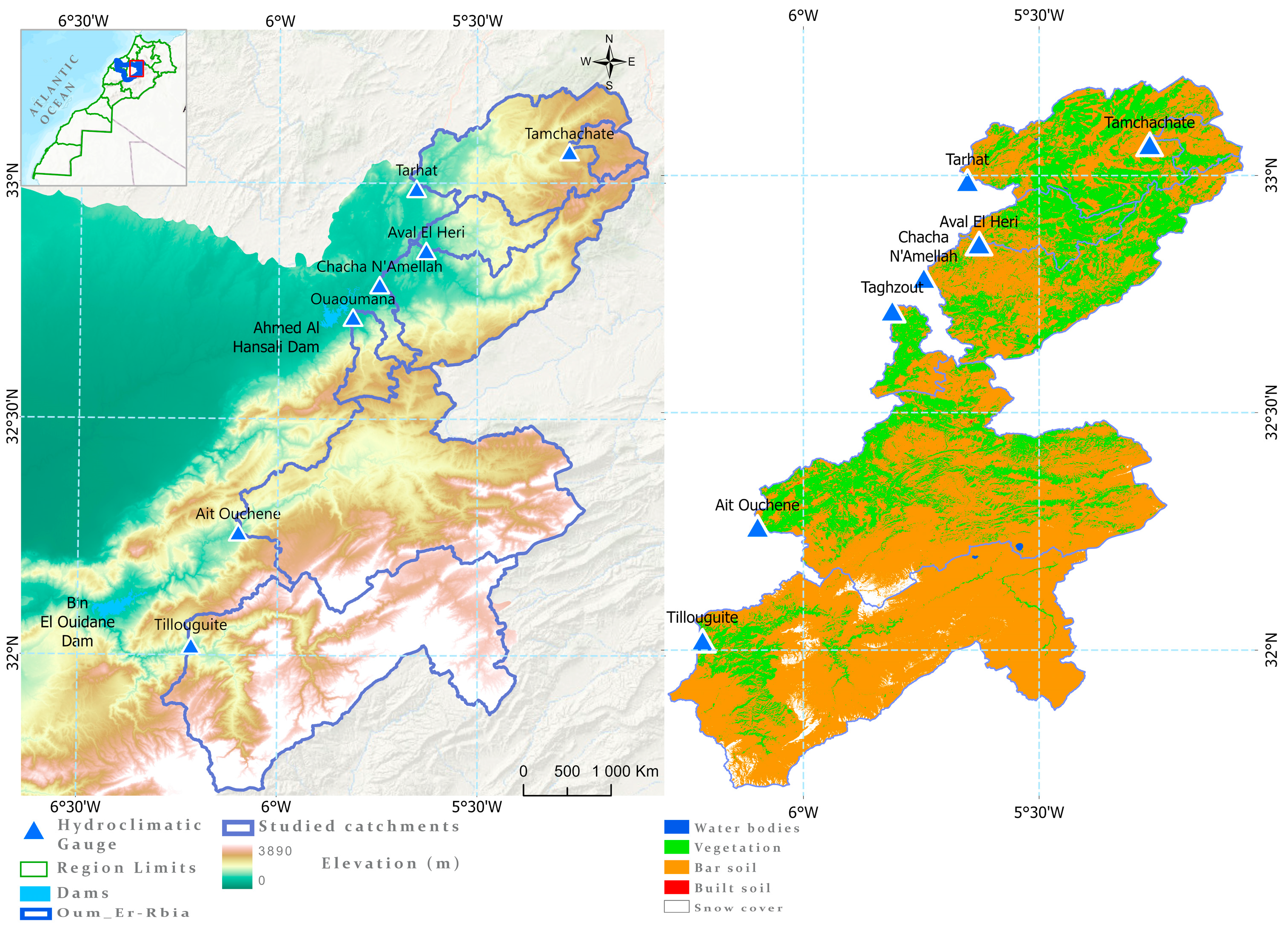
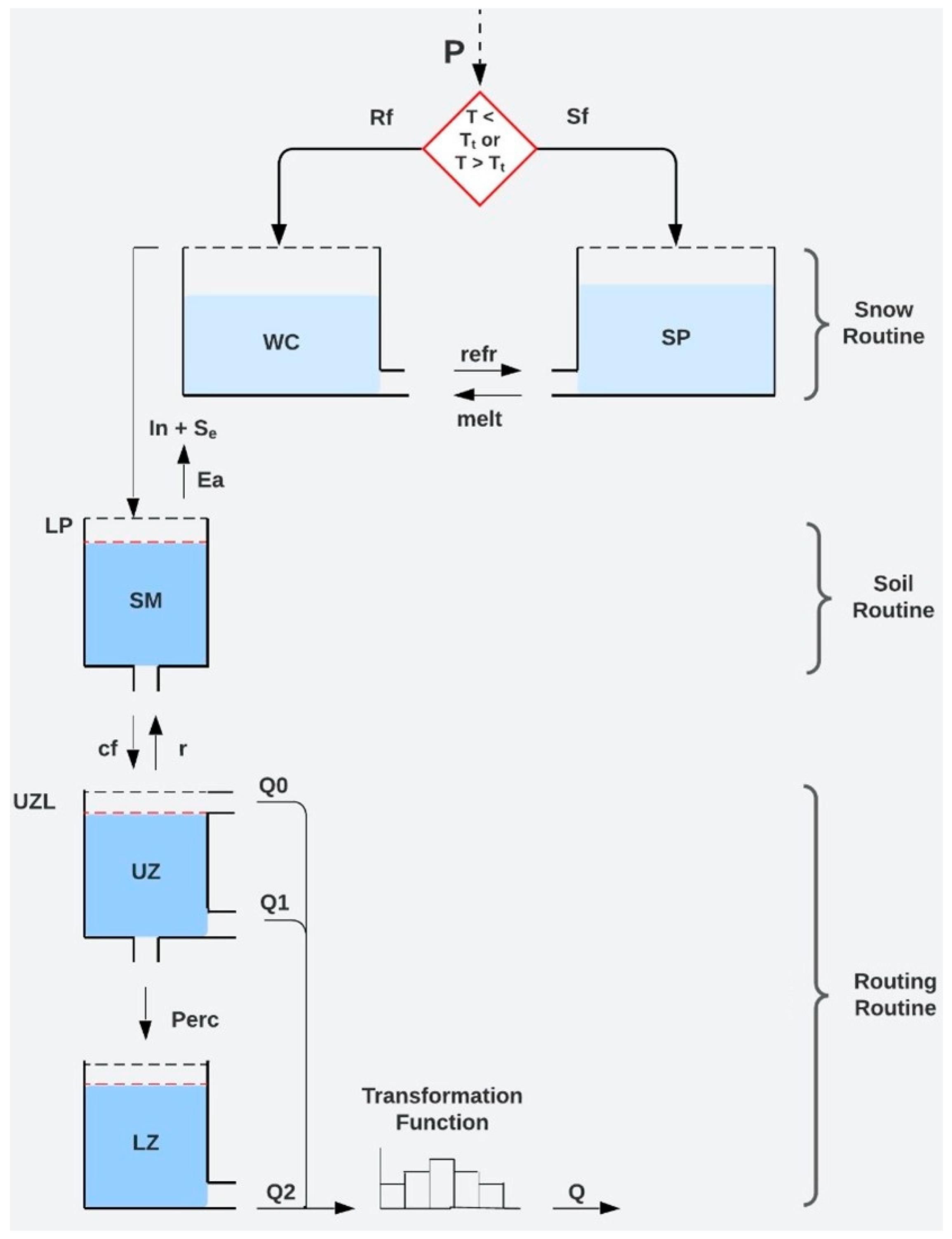
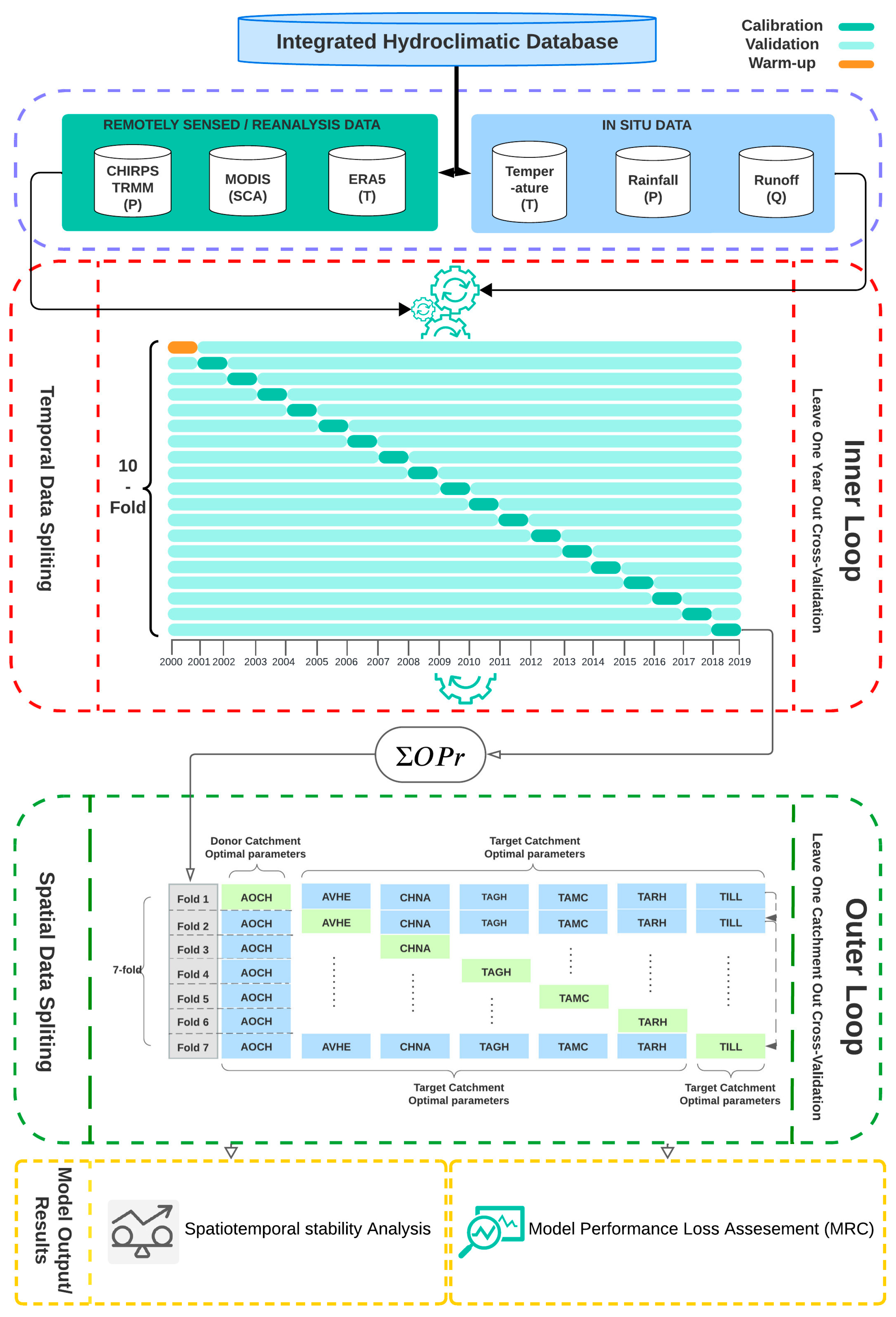
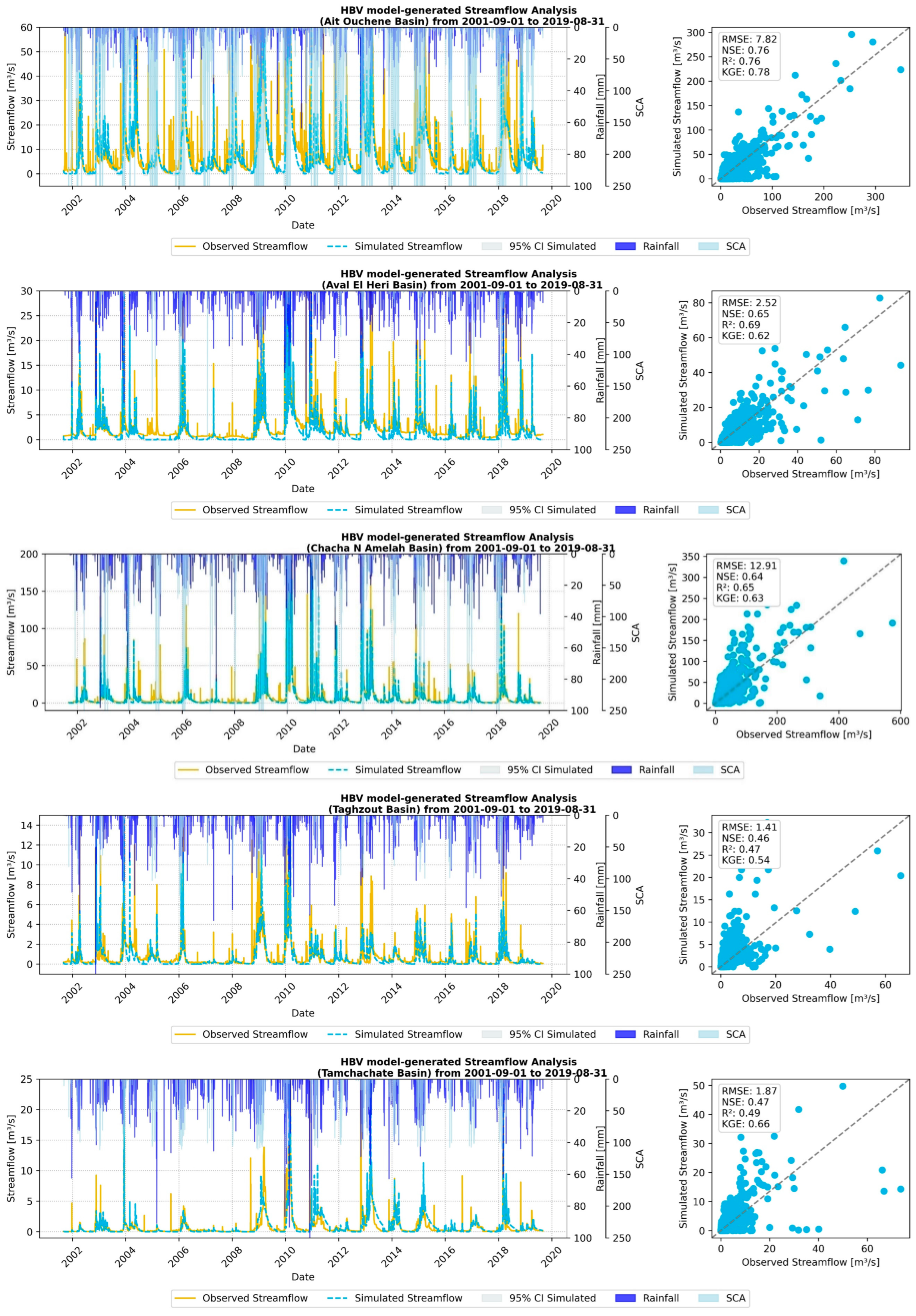
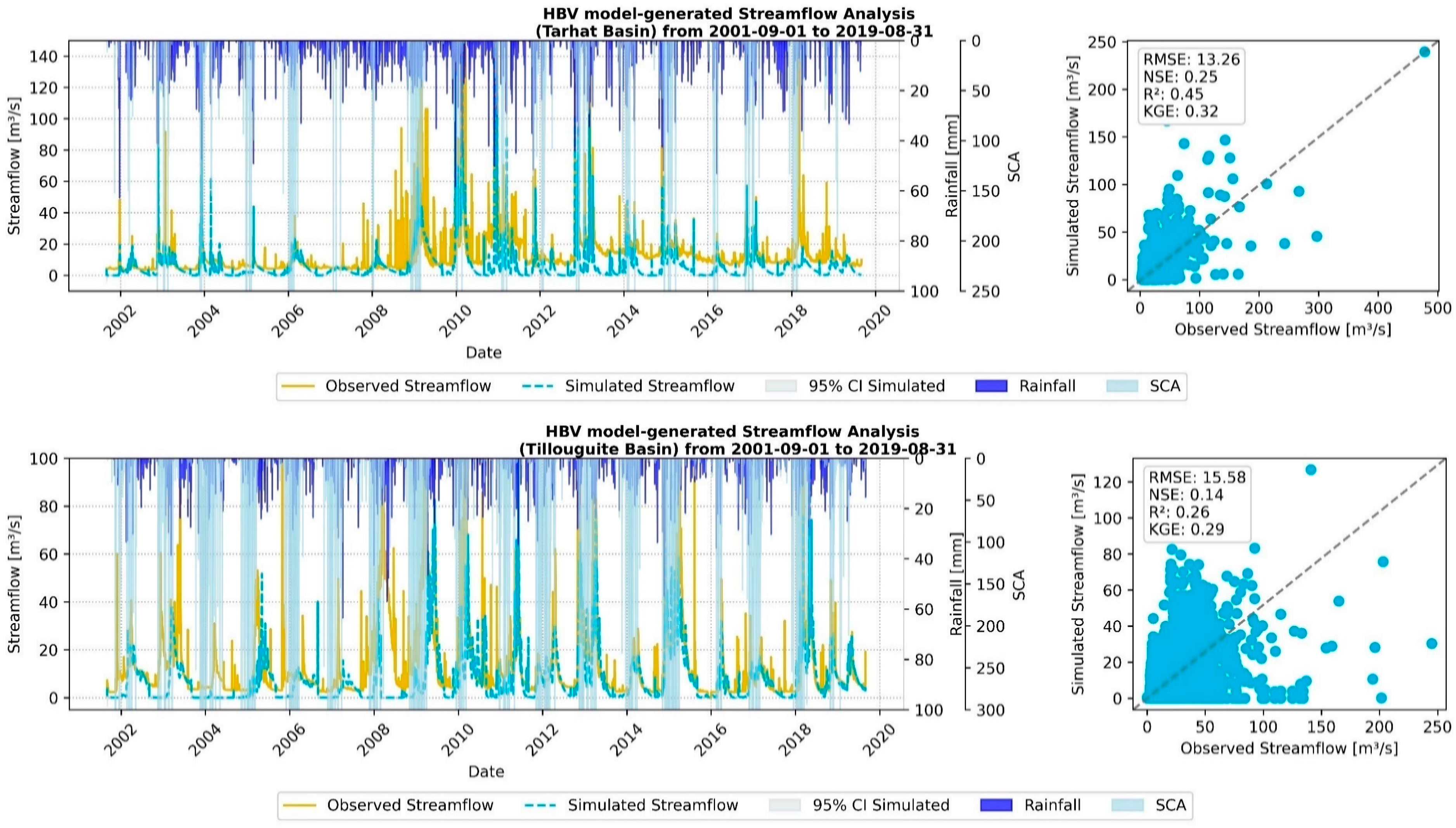

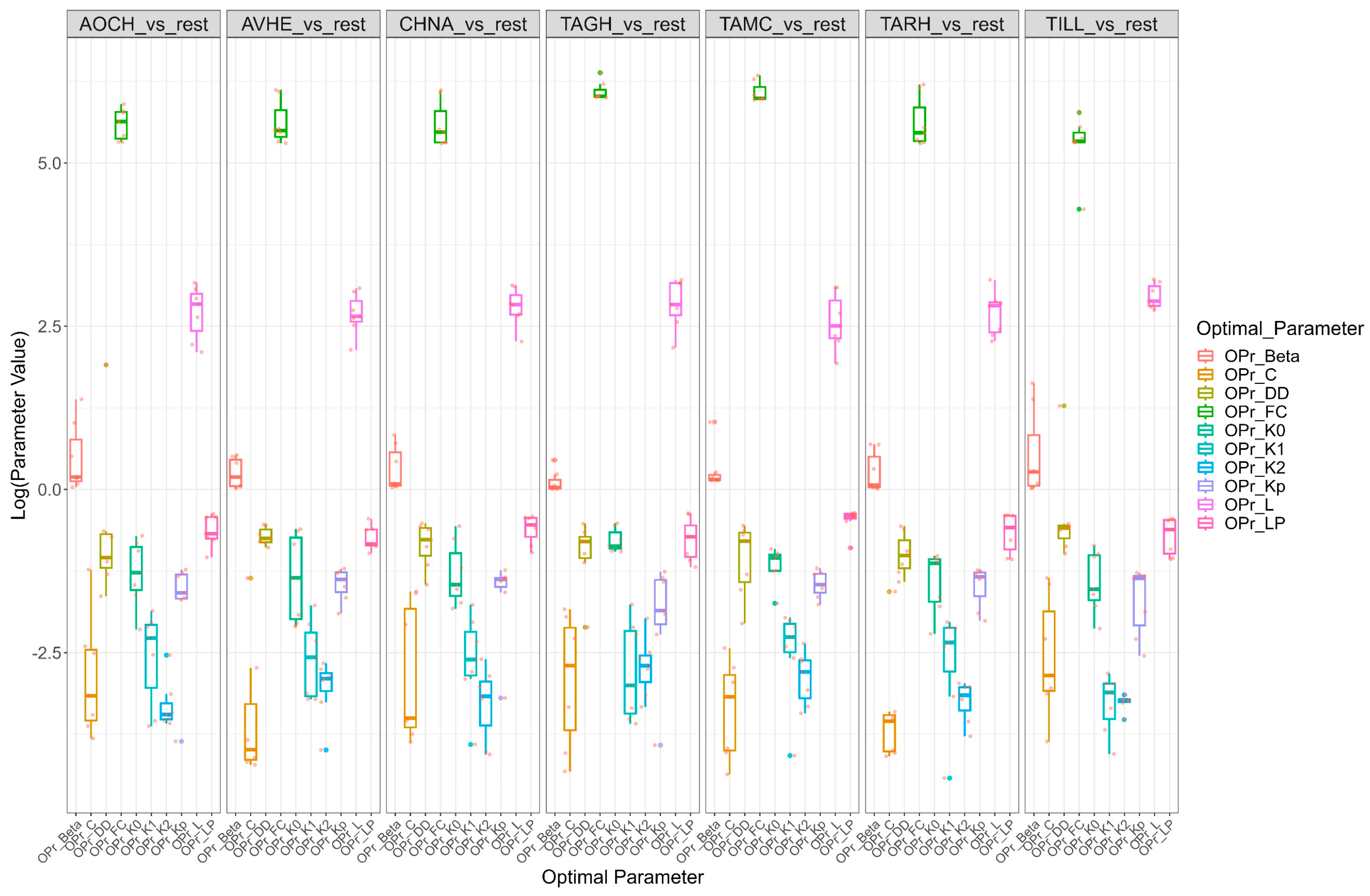
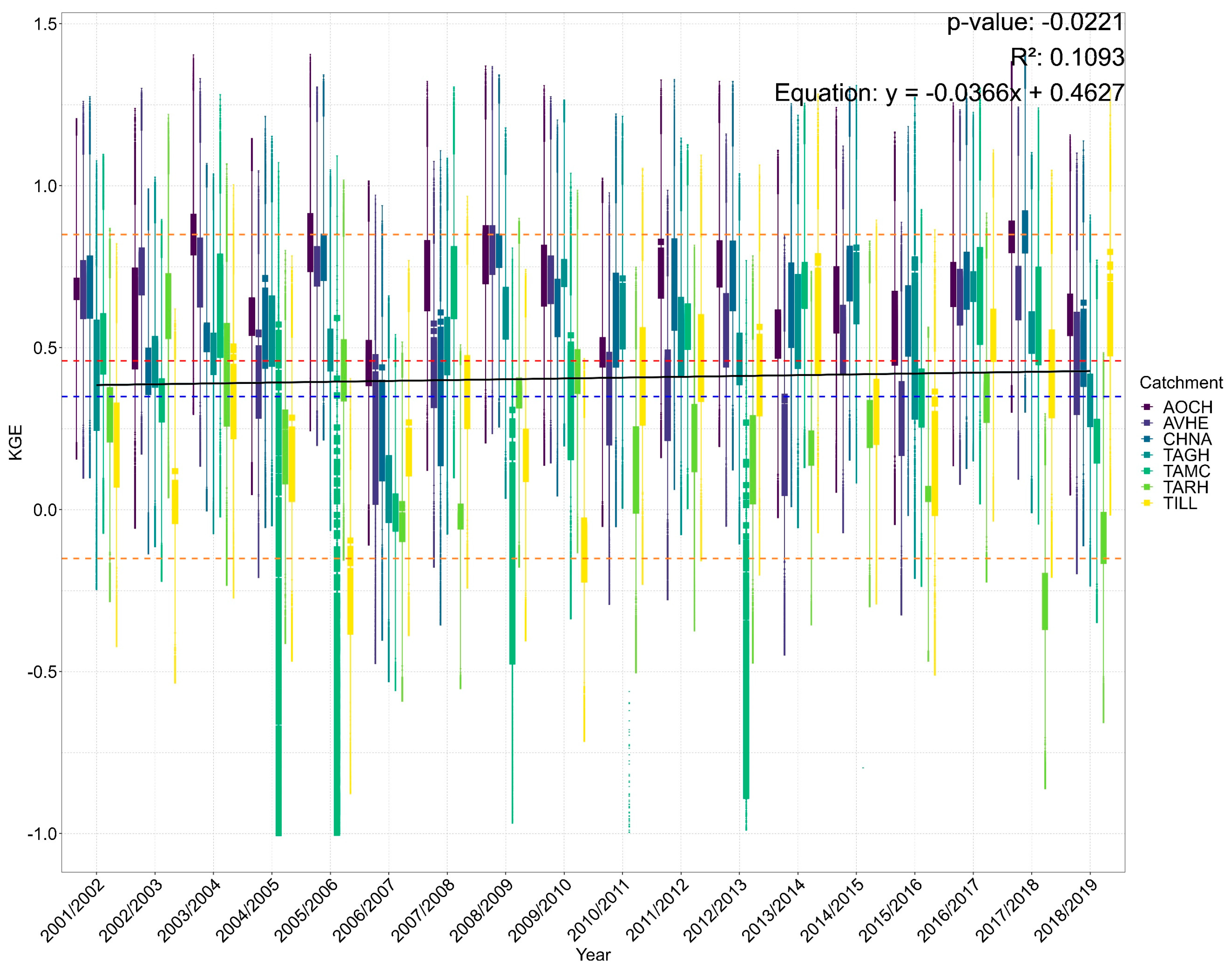
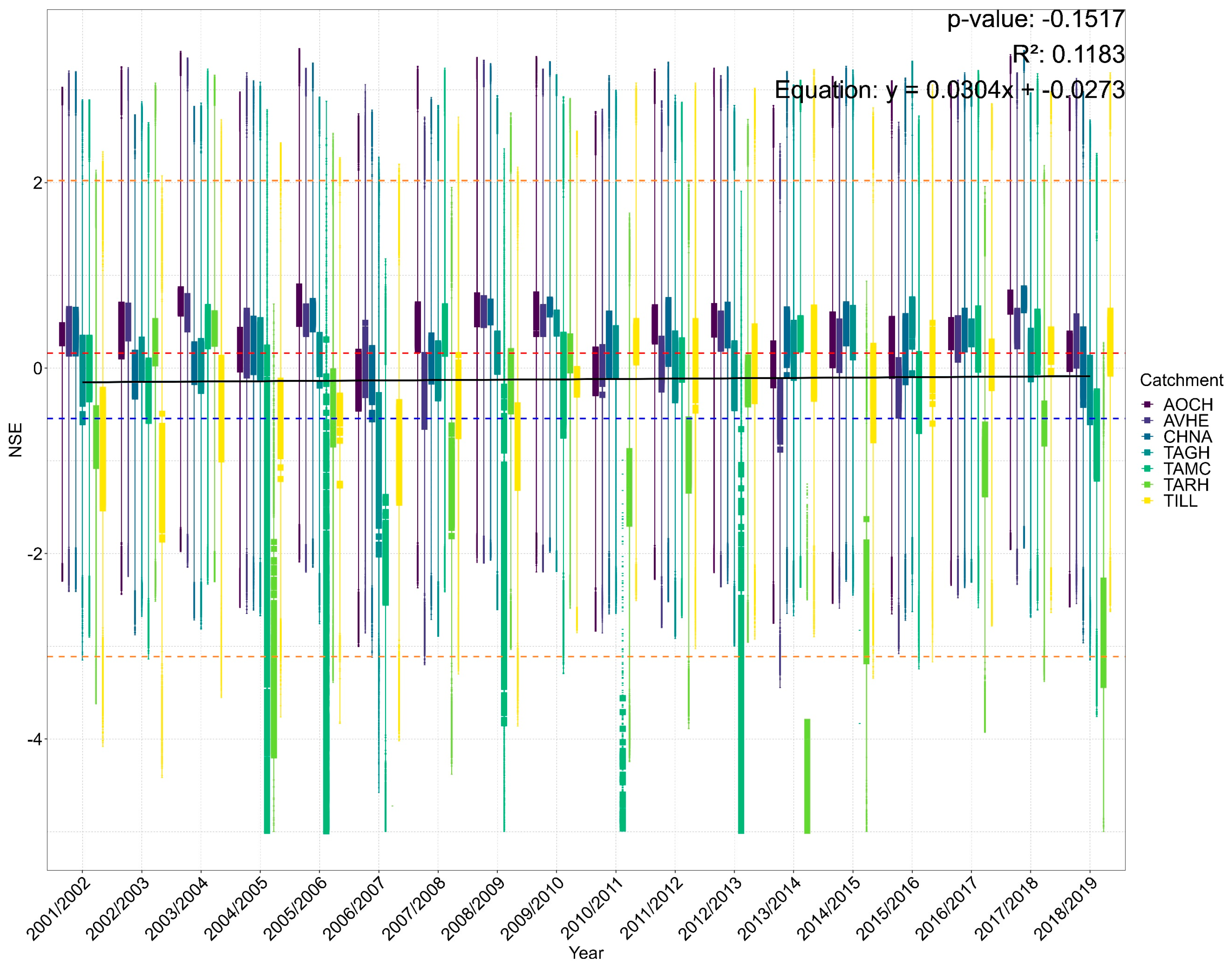

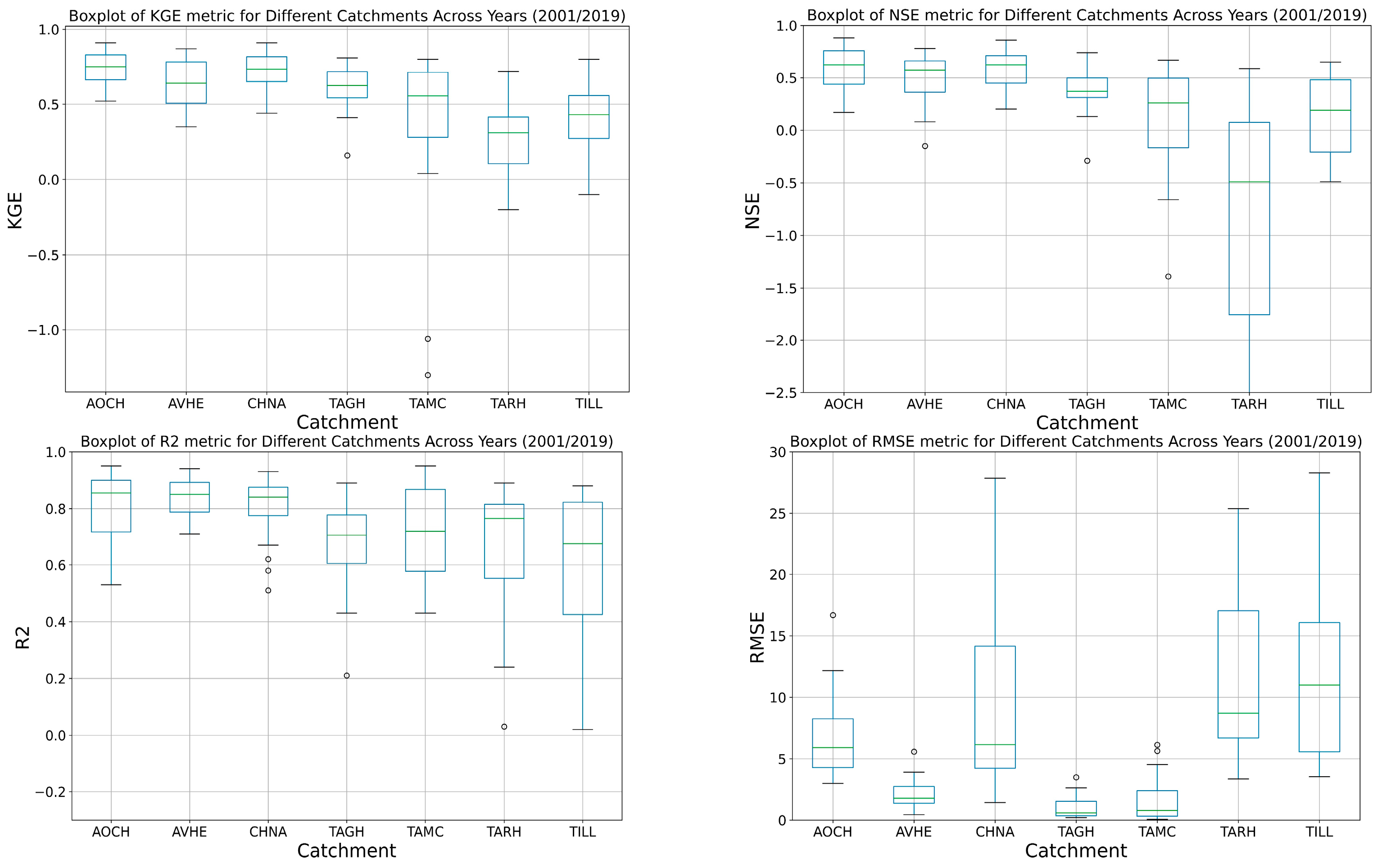
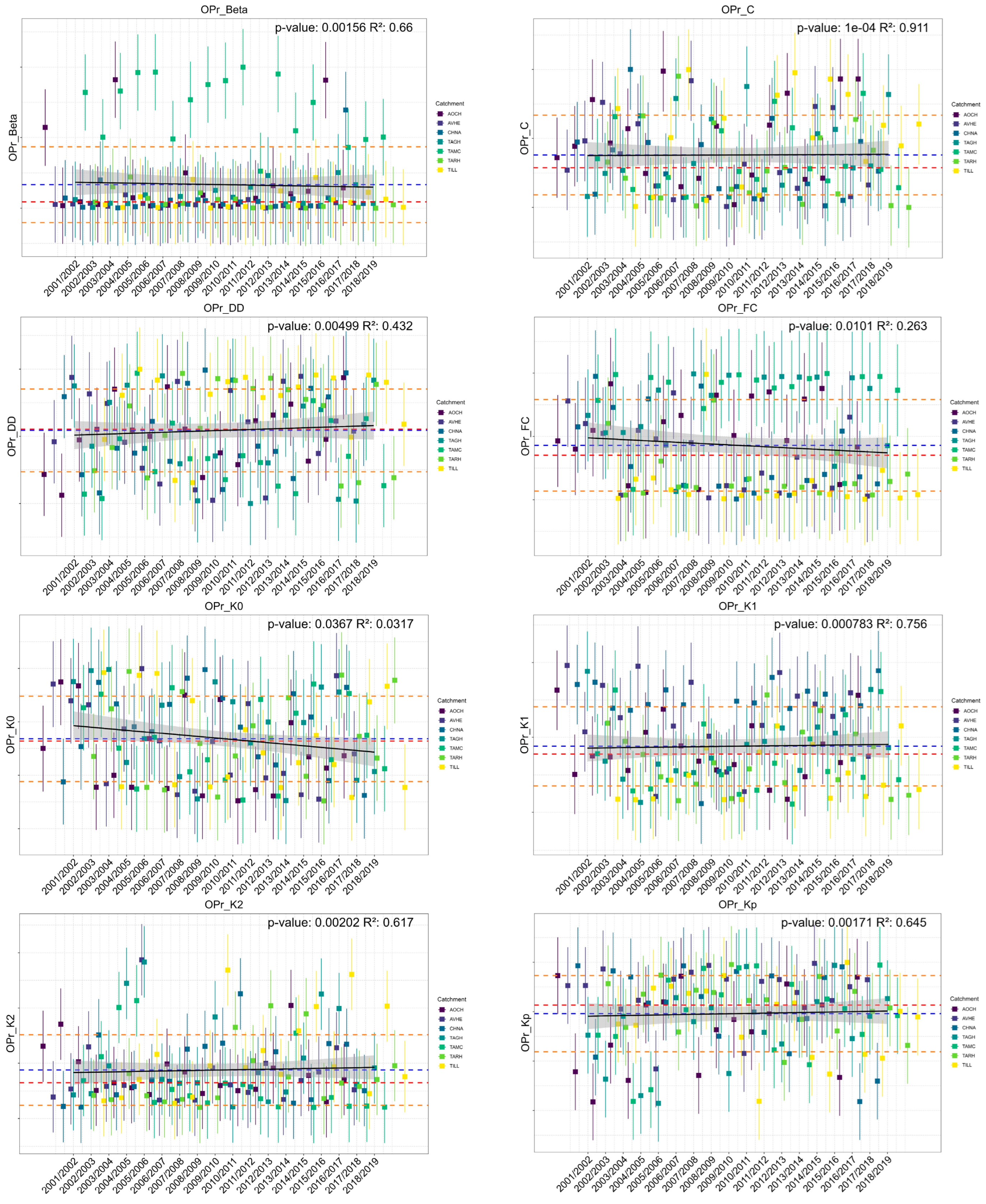

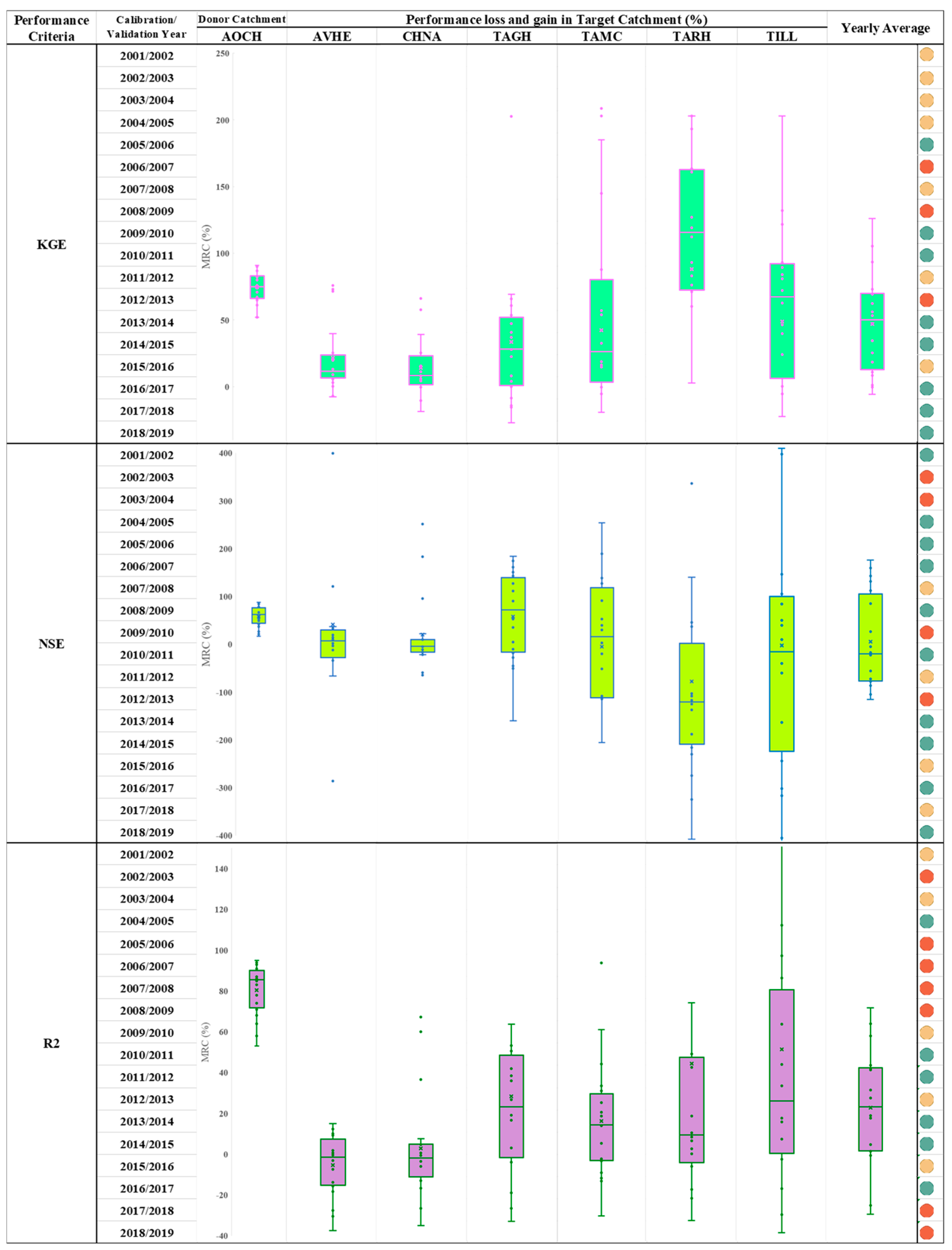

| Basin | Catchment Characteristics | Hydrologic Characteristics | |||||||
|---|---|---|---|---|---|---|---|---|---|
| ID | Name | Area (Km2) | Slope (%) | P (mm/Day) | Q (m3.s−1/Day) | AET (mm/Day) | SWE (mm/Day) | MSI | VF |
| AOCH | Ait Ouchene | 2381 | 26.3 | 1.24 | 9.90 | 4.08 | 0.81 | 1.04 | 0.65 |
| AVHE | Aval El Heri | 329 | 17.8 | 1.67 | 2.39 | 4.02 | 0.12 | 0.92 | 0.77 |
| CHNA | Chacha N’Amellah | 1400 | 19.6 | 1.50 | 8.67 | 3.98 | 0.14 | 0.98 | 0.78 |
| TAGH | Taghzout | 208 | 21.1 | 1.49 | 0.92 | 4.01 | 0.13 | 1.04 | 0.72 |
| TAMC | Tamchachate | 340 | 13.8 | 1.90 | 0.79 | 3.83 | 0.38 | 1.04 | 0.70 |
| TARH | Tarhat | 1026 | 18.1 | 1.71 | 12.11 | 3.93 | 0.21 | 1.00 | 0.78 |
| TILL | Tillouguite | 2030 | 33.9 | 1.16 | 14.39 | 4.09 | 0.65 | 1.15 | 0.71 |
| Model Parameter | Routine | Unit | Range (Min–Max) |
|---|---|---|---|
| Shape coefficient (BETA) | Soil | - | 1–4 |
| Temperature correction factor (C) | Snow | °C−1 | 0.01–0.3 |
| Degree day factor (DDF) | Snow | mm °C−1 d−1 | 0.1–0.6 |
| Field capacity (FC) | Soil | mm | 200–600 |
| Very fast storage coefficient (k0) | Runoff | d−1 | 0.1–0.6 |
| Fast storage coefficient (k1) | Runoff | d−1 | 0.01–0.2 |
| Slow storage coefficient (k2) | Runoff | d−1 | 0.01–0.15 |
| Percolation rate (Kp) | Runoff | d−1 | 0.01–0.3 |
| Upper storage coefficient (UZL) | Runoff | mm | 5–25 |
| Limit for potential evapotranspiration (LP) | Soil | - | 0.3–1 |
| Catchment | BETA | C | DD | FC | K0 | K1 | K2 | L | Kp | LP | KGE | NSE | R2 | RMSE | RVE |
|---|---|---|---|---|---|---|---|---|---|---|---|---|---|---|---|
| AOCH | 2.3451 | 0.0917 | 0.4694 | 236.8616 | 0.4018 | 0.0833 | 0.0262 | 22.0232 | 0.0690 | 0.6031 | 0.8087 | 0.8042 | 0.9195 | 16.1107 | −0.2971 |
| AVHE | 1.0072 | 0.0101 | 0.4825 | 210.8385 | 0.2286 | 0.1021 | 0.0180 | 15.1770 | 0.2925 | 0.6888 | 0.7749 | 0.6716 | 0.8275 | 5.5344 | −0.1680 |
| CHNA | 1.0086 | 0.0195 | 0.4122 | 221.8037 | 0.4684 | 0.1554 | 0.0350 | 10.7412 | 0.1780 | 0.4693 | 0.7029 | 0.7522 | 0.8722 | 27.1942 | −0.2117 |
| TAGH | 1.2290 | 0.0120 | 0.2356 | 560.7553 | 0.5943 | 0.0866 | 0.0819 | 23.6163 | 0.0300 | 0.4225 | 0.7645 | 0.6166 | 0.7891 | 2.5682 | −0.1786 |
| TAMC | 3.4315 | 0.0373 | 0.5252 | 584.0452 | 0.1949 | 0.0147 | 0.0770 | 24.9868 | 0.2965 | 0.3195 | 0.5385 | 0.5468 | 0.7433 | 5.1625 | −0.2123 |
| TARH TILL | 1.0965 | 0.2575 | 0.3743 | 258.0857 | 0.1683 | 0.0598 | 0.0389 | 17.8828 | 0.2659 | 0.6214 | 0.4860 | 0.4006 | 0.6493 | 24.1965 | −0.1091 |
| 1.0812 | 0.2310 | 0.5698 | 205.0131 | 0.1878 | 0.0170 | 0.0705 | 21.1327 | 0.2616 | 0.3953 | 0.2308 | 0.2175 | 0.5163 | 24.6555 | −0.2865 |
| Parameters | Min | Max | Avrg | StD |
| OPr_Beta (-) | 1.0059 | 5.0947 | 1.5195 | 0.8602 |
| OPr_C (mm.d−1) | 0.0127 | 0.2930 | 0.0733 | 0.0770 |
| OPr_DD (mm/°C.d−1) | 0.1212 | 6.7420 | 0.6190 | 1.0098 |
| OPr_FC (mm) | 73.1931 | 591.1099 | 321.5628 | 121.4521 |
| OPr_K0 (d−1) | 0.1095 | 0.5961 | 0.3190 | 0.1368 |
| OPr_K1 (d−1) | 0.0120 | 0.1719 | 0.0811 | 0.0464 |
| OPr_K2 (d−1) | 0.0172 | 0.1389 | 0.0490 | 0.0223 |
| OPr_Kp (mm.d−1) | 0.0199 | 0.2990 | 0.2164 | 0.0754 |
| OPr_L (mm) | 6.8913 | 24.9554 | 16.4839 | 5.2186 |
| OPr_LP (-) | 0.3043 | 0.6982 | 0.5331 | 0.1291 |
| Performance Metrics | Min | Max | Avrg | StD |
| KGE | −1.30 | 0.91 | 0.53 | 0.32 |
| NSE | −0.08 | 0.81 | 0.53 | 0.23 |
| R2 | 0.39 | 0.94 | 0.75 | 0.15 |
| RMSE (m3/S) | 3.83 | 55.32 | 24.96 | 16.48 |
| RVE | −0.56 | 0.57 | −0.04 | 0.32 |
| AVG_NSE | −0.39 | 0.70 | 0.31 | 0.28 |
Disclaimer/Publisher’s Note: The statements, opinions and data contained in all publications are solely those of the individual author(s) and contributor(s) and not of MDPI and/or the editor(s). MDPI and/or the editor(s) disclaim responsibility for any injury to people or property resulting from any ideas, methods, instructions or products referred to in the content. |
© 2024 by the authors. Licensee MDPI, Basel, Switzerland. This article is an open access article distributed under the terms and conditions of the Creative Commons Attribution (CC BY) license (https://creativecommons.org/licenses/by/4.0/).
Share and Cite
El Garnaoui, M.; Boudhar, A.; Nifa, K.; El Jabiri, Y.; Karaoui, I.; El Aloui, A.; Midaoui, A.; Karroum, M.; Mosaid, H.; Chehbouni, A. Nested Cross-Validation for HBV Conceptual Rainfall–Runoff Model Spatial Stability Analysis in a Semi-Arid Context. Remote Sens. 2024, 16, 3756. https://doi.org/10.3390/rs16203756
El Garnaoui M, Boudhar A, Nifa K, El Jabiri Y, Karaoui I, El Aloui A, Midaoui A, Karroum M, Mosaid H, Chehbouni A. Nested Cross-Validation for HBV Conceptual Rainfall–Runoff Model Spatial Stability Analysis in a Semi-Arid Context. Remote Sensing. 2024; 16(20):3756. https://doi.org/10.3390/rs16203756
Chicago/Turabian StyleEl Garnaoui, Mohamed, Abdelghani Boudhar, Karima Nifa, Yousra El Jabiri, Ismail Karaoui, Abdenbi El Aloui, Abdelbasset Midaoui, Morad Karroum, Hassan Mosaid, and Abdelghani Chehbouni. 2024. "Nested Cross-Validation for HBV Conceptual Rainfall–Runoff Model Spatial Stability Analysis in a Semi-Arid Context" Remote Sensing 16, no. 20: 3756. https://doi.org/10.3390/rs16203756







